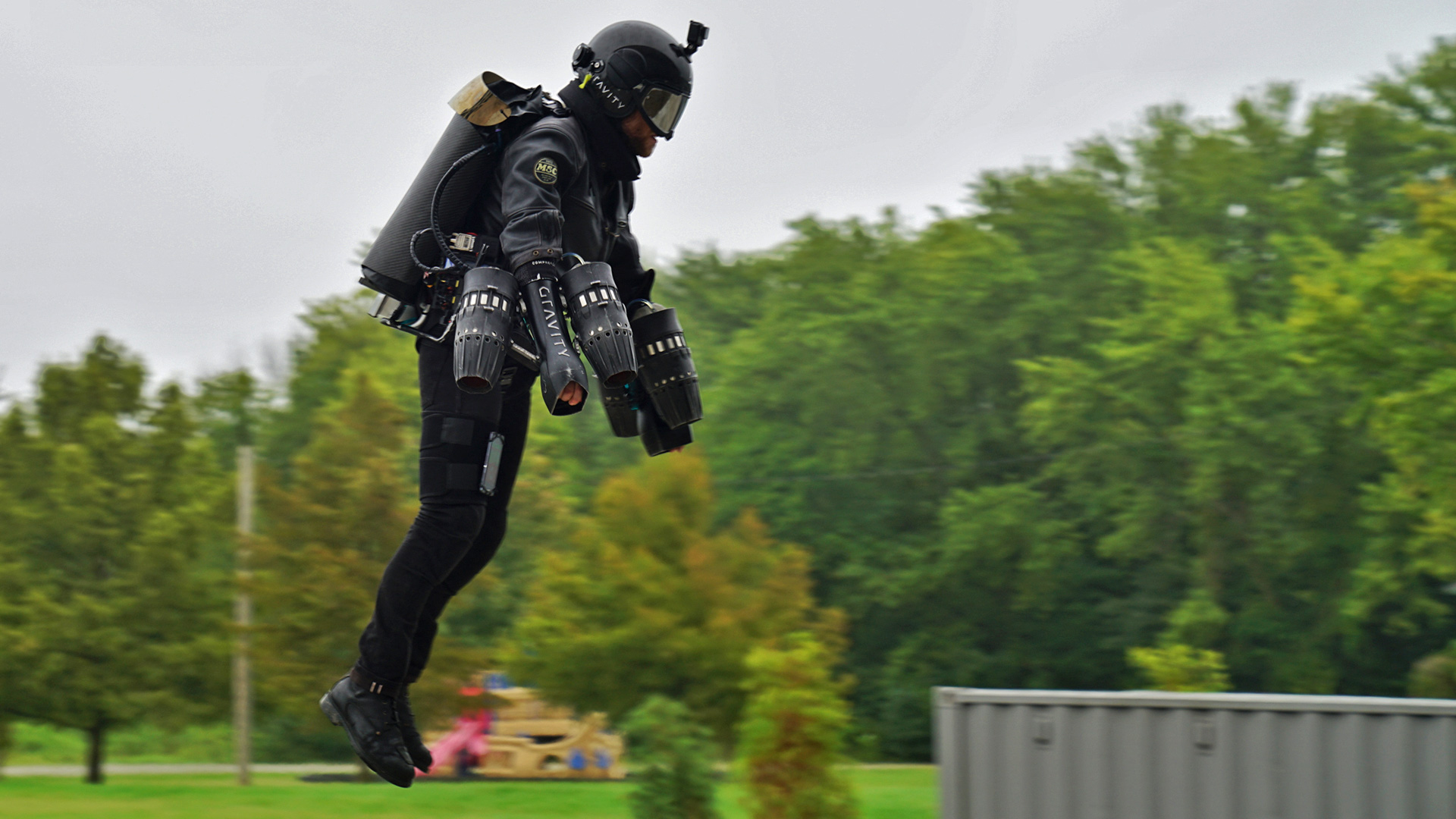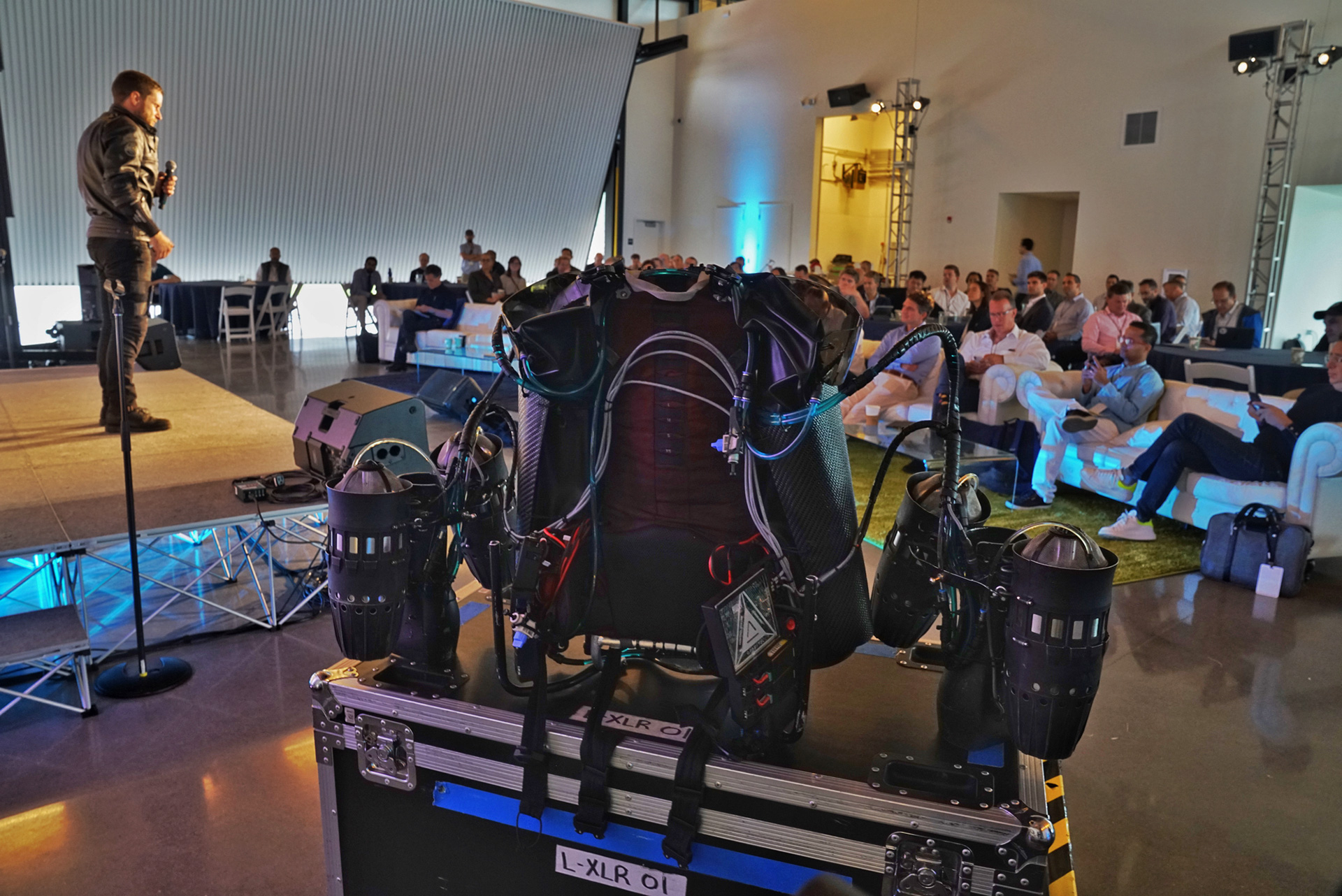

If there’s a surefire way to get people stoked about a new form of transportation, it’s to race the bejeezus out of it. Cars, airplanes, bikes, boats, balloons—all proved their mettle in the heat of competition early in their existence. Now, it’s the jetpack’s turn. At a secretive air mobility conference in Arkansas last weekend, the founder of a British startup called Gravity Industries announced he intends to launch a racing series using the jet-powered flight suit he created and began demonstrating last year.
London-based Richard Browning, a former oil trader, Royal Marine reservist, and endurance athlete who turned to a life of invention, showed off his handiwork at Bentonville UP, an invitation-only gathering of the air-taxi and electric-aviation innovators from such companies as Uber, Google, Airbus, Joby Aviation, and Virgin Galactic. Not surprisingly, Browning showed up at the conference under his own power, arriving in a blaze of kerosene-powered thrust generated by five miniature jet engines—two mounted on each arm and one affixed to his back. The combined output from the microturbine engines is over 1,000 horsepower—each produces almost 300-foot-pounds of force—for two-to-three-minute flights, yet Browning says it’s all manageable—and safe.

“It’s like a camera tripod, with the pilot stabilized by the three thrust points, using his or her arms to steer around in a very natural way,” he said of the suit, dubbed Daedalus Mark 1. “It also has a nice center of gravity, compared to other systems where the pilot stands on a platform or has ankle-mounted thrusters. It taps beautifully into your innate balance system.”
The system provides engine and speed data to the pilot via a head-up display in the helmet, and the pilot steers by smoothly adjusting the arm-mounted thrusters. Those engines don’t burn the pilot because the heat dissipates quickly, and it doesn’t take tremendous strength to support the arm thrusters.
“We can teach someone to fly this in just 15 minutes,” Browning said. “It doesn’t rip your arms off or throw you around.”
Plus, it’s surprisingly safe. If one (or all) of the engines fail, they automatically spool down slowly, so the worst thing that can happen is a slow descent to the surface. And f that surface happens to be water, a built-in life preserver will automatically inflate.
To date, Browning has demonstrated the technology at 58 events in 19 countries, setting Guinness speed records for “body-controlled jet engine powered suit”—something he admits doesn’t carry a lot of weight, since he’s the first to set the record. Still, the suit performance has steadily improved in just the two years he and his team have been developing it. So far he’s reached a maximum of 45 mph, but says the suit is capable of 200 mph, up to 10,000 feet of altitude, and 10-minute flight times.
He’s pursuing interest from military and search-and-rescue entities, as well as private owners, to whom he sells the suit and training for just shy of $500,000. He readily admits, however, that the best route to launching his program has been entertainment—exhibition flights, festivals and other events, potential upcoming movie appearances, and now, his new jetpack racing league. He describes it as akin to Red Bull’s airplane racing series, with pilots careening around pylons and—in the flying suit’s case—confronting challenges like obstacles and touch-and-go platforms the pilots will have to land on and traverse on foot before leaping back into the air.

Gravity expects to launch the series next year, with six teams comprised of two pilots each, using three suits in total. The races will be conducted over water and relatively low to the ground, for safety purposes. Because the technology is small-scale and not dependent on vehicle development and certification, it stands a much stronger chance of success than another recent—and notorious—new-fangled racing series proposal: the Rocket Racing League. That launched more than a decade ago with the idea of rocket-powered airplanes racing NASCAR-style along huge circuits in the sky, but eventually fizzled out before a single race took place due to the cost of developing the new aircraft.
If Gravity’s effort takes off, Browning hopes it will pave the way for a new kind of mobility. “Racing is one of the best ways to accelerate technology, and it’s only trumped by war,” he said. ”The electric version of this that we’re developing doesn’t have the power density of the kerosene system just yet, but it’s very promising, and this will hopefully help push that harder, too,” he says—finally giving hope to legions of enthusiasts who’ve been waiting not-quite-patiently for decades for the day that jetpacks will finally take them to work, school, and the mall.